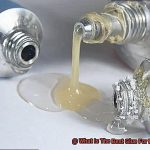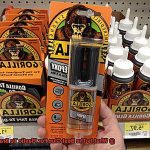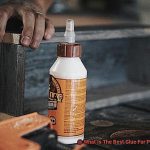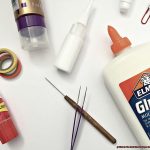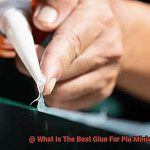Are you sick of the endless hunt for the ultimate glue to bond plastic and acrylic?
Well, your search ends here. We get it – finding the perfect adhesive can be a real pain in the neck.
But don’t worry, we’ve got your back. Whether you’re fixing broken plastic toys or creating mind-blowing acrylic crafts, we’ve got just the thing for you.
In this blog post, we’re going to dive into the world of glues that are specifically designed to conquer the challenge of bonding plastic and acrylic materials. Say goodbye to weak connections that leave you hanging, and get ready to discover an adhesive that will blow your mind.
So let’s jump right in and find out which glue reigns supreme.
Different Types of Glue for Plastic and Acrylic
Contents
Choosing the right glue is crucial when it comes to joining plastic and acrylic materials. The type of glue you use can determine the strength and durability of the bond. In this article, we will explore the different types of glue that are commonly used for bonding plastic and acrylic materials.
Cyanoacrylate Glue (Super Glue):
One popular choice for bonding plastic and acrylic is cyanoacrylate glue, also known as super glue. This adhesive forms a strong and durable bond that sets quickly. It works by creating a chemical reaction with moisture in the air, which causes it to harden and create a tight seal. However, it’s important to note that super glue may not be suitable for all types of plastics or acrylics, so testing it on a small area is recommended.
Epoxy Resin:
Epoxy resin is a versatile adhesive known for its strength and durability. It consists of two components, a resin and a hardener, which need to be mixed together before application. Once mixed, epoxy resin creates a strong bond that can withstand heavy loads and extreme temperatures. It is an excellent choice for bonding larger or more complex plastic and acrylic pieces.
Polyurethane Adhesive:
Polyurethane adhesive offers flexibility and resistance to moisture, making it suitable for both indoor and outdoor applications. This adhesive forms a strong bond and can withstand temperature fluctuations, making it reliable for bonding plastic and acrylic.
Acrylic Cement:
For bonding acrylic specifically, acrylic cement is the go-to adhesive. This solvent-based adhesive chemically bonds acrylic together by dissolving the surface of the material. As the solvent evaporates, a strong bond is formed. Acrylic cement is commonly used in applications where a seamless bond is desired, such as in acrylic fabrication or model-making.
Silicone Adhesive:
Silicone adhesive is commonly used for bonding plastic and acrylic materials that require flexibility and resistance to moisture. It forms a flexible bond that can withstand variations in temperature and movement. However, silicone adhesive may not provide as strong a bond as other types of glues, so it may not be suitable for all applications.
Conclusion:
Choosing the right glue for bonding plastic and acrylic is essential for achieving a strong and durable bond. Consider factors such as the type of material, desired strength, and environmental conditions when selecting a glue. Always follow the manufacturer’s instructions and test the adhesive on a small area before applying it to the entire surface.
Cyanoacrylate Adhesive (Super Glue)
Look no further than cyanoacrylate adhesive, also known as super glue. This versatile adhesive offers a range of benefits that make it an ideal choice for your bonding needs.
First and foremost, one of the biggest advantages of using cyanoacrylate adhesive is its quick-drying properties. Unlike other glues that require hours of drying time, super glue sets within seconds to minutes. Say goodbye to the hassle of waiting for your project to dry and move on to the next step in no time.
But it’s not just the fast drying time that makes super glue great. It also forms a strong bond. Once applied, this powerful glue can withstand tension, shear, and impact forces. Whether you’re repairing a broken plastic item or creating a DIY masterpiece, trust that your bond will hold strong.
And let’s talk about versatility. Cyanoacrylate adhesive works on a wide range of plastic and acrylic materials including polycarbonate, ABS, and PVC. So whether you’re working on a hobby project or fixing something around the house, super glue has got you covered.
However, it’s important to note that not all plastics are compatible with cyanoacrylate adhesive. Plastics such as polyethylene and polypropylene have low surface energy and may not bond well with super glue. In these cases, it’s best to use specialty adhesives designed specifically for these types of plastics.
To ensure a successful bond, proper surface preparation is key. Make sure the surfaces to be bonded are clean, dry, and free from any grease, oil, or contaminants. You can even lightly sand the surfaces to create a rougher texture for the glue to grip onto.
Epoxy Adhesive
In the realm of glues, one adhesive stands out as the ultimate hero when it comes to bonding plastic and acrylic materials. Epoxy adhesive, with its versatility, strength, and resistance to chemicals and moisture, is the go-to solution for various applications. Join us as we delve into the numerous benefits that epoxy adhesive offers and why it’s the unbreakable bond that holds plastics and acrylics together.
Versatility:
Epoxy adhesive is a true superhero when it comes to bonding different types of plastics and acrylics. Whether you’re working with PVC, ABS, polycarbonate, or acrylic sheets, epoxy adhesive provides a reliable and long-lasting bond. From repairing broken plastic items to assembling plastic components or creating stunning artistic projects using acrylic materials, epoxy adhesive is your versatile sidekick.
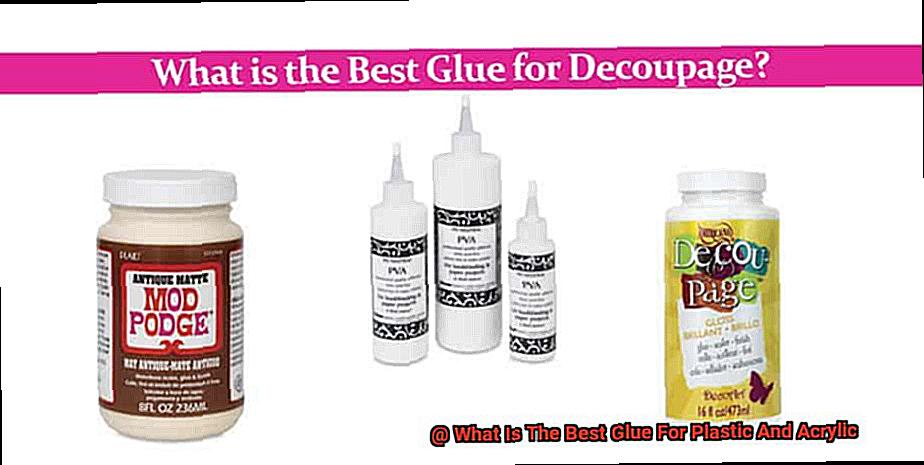
Surface Preparation:
To unlock the full potential of epoxy adhesive, proper surface preparation is crucial. The surfaces must be clean, dry, and free from dust or grease. Lightly sanding the surfaces creates a rough texture, enhancing the adhesion of the epoxy. Some epoxy adhesives require mixing two components – resin and hardener – in specific ratios before application. Following the manufacturer’s instructions ensures optimal results.
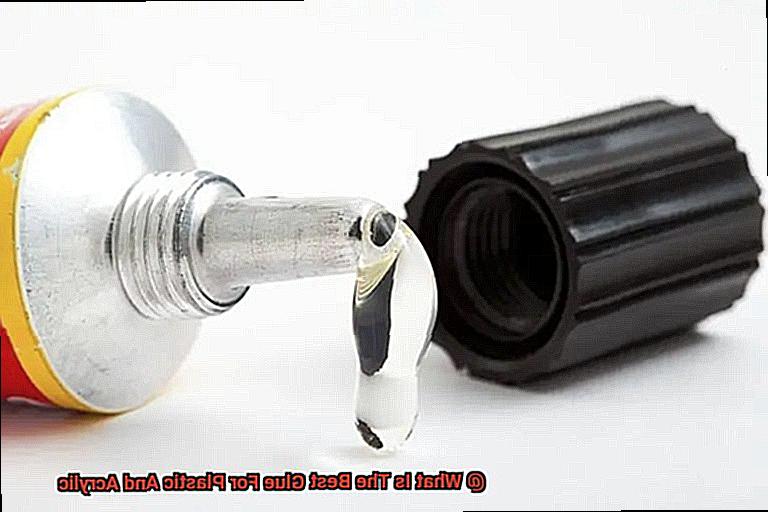
Curing Time:
Unlike other glues, epoxy adhesive boasts a longer curing time. This feature allows for precise alignment and adjustment of bonded parts before the adhesive sets completely. Apply even pressure during the curing process to ensure a strong and secure bond. Once cured, epoxy adhesive forms a solid and durable bond capable of withstanding various stresses and environmental conditions.
Strength and Durability:
Renowned for its high strength and durability, epoxy adhesive can withstand heavy loads, impacts, and vibrations without compromising the bond between plastic or acrylic materials. Its excellent resistance to chemicals and moisture makes it suitable for both indoor and outdoor applications. With epoxy adhesive, your bonds will remain unbreakable and stand the test of time.
Polyolefin Adhesive
Look no further. Polyolefin adhesive is here to save the day. This specialized glue is a game-changer when it comes to bonding polyolefin surfaces, offering unmatched strength, versatility, and durability. In this article, we’ll dive into the world of polyolefin adhesive, exploring its benefits and proper application techniques.
Superpower #1: Compatibility with Different Polyolefins
Polyolefin adhesive possesses the incredible ability to bond various types of polyolefins, such as HDPE, LDPE, and PP. No more searching for different adhesives for different plastics. Whether you’re working with packaging materials, automotive parts, toys, or household products, polyolefin adhesive has got your back.
Superpower #2: Resilience in Harsh Environments
Polyolefin adhesive is built to withstand even the toughest conditions. With excellent resistance to chemicals, moisture, and temperature fluctuations, it ensures that your bonds remain intact in any environment. Harsh chemicals or extreme temperatures won’t stand a chance against polyolefin adhesive’s superior strength.
Application Techniques:
To unlock the full potential of polyolefin adhesive, proper surface preparation is essential. Cleanliness is key – make sure the surfaces to be bonded are free from contaminants like dirt, grease, or oils. A thorough cleaning using a suitable solvent or cleaning agent is recommended.
Polyolefin adhesive typically comes in two-component systems labeled as Part A and Part B. Mix these components in the correct ratio specified by the manufacturer. Apply the mixed adhesive onto the prepared surfaces using a brush, roller, or syringe.
Once applied, firmly press the parts together to ensure good contact and proper bonding. Clamps or other forms of mechanical pressure can be used to hold the parts in place until the adhesive cures. Curing time may vary depending on the adhesive and environmental conditions, so follow the manufacturer’s instructions for the recommended time.
Choosing the Right Glue for Plastic and Acrylic
Are you searching for the perfect glue to bond your plastic or acrylic materials? Look no further. Selecting the right glue is crucial for the success of your project. With countless options available, it can be overwhelming to make a choice. But fear not, I’m here to assist you.
First and foremost, consider the type of plastic or acrylic you are working with. Each type has distinct properties that may necessitate a specific glue for optimal bonding. Take some time to research and identify the type you are dealing with.
Next, evaluate the strength and durability of the bond required. If your project involves heavy-duty applications, opt for a strong adhesive that can withstand stress and strain. For lighter-duty projects, a more flexible glue may be sufficient.
Drying time is another critical factor to consider. Some glues dry rapidly, facilitating quicker assembly. Others may take longer. If you’re in a rush, opt for a fast-drying adhesive. However, bear in mind that faster drying glues may not allow for repositioning once the bond is established.
Compatibility is key. Ensure that the glue you select is compatible with both the plastic or acrylic and any other materials involved. You don’t want unexpected reactions or weakened bonds. Always refer to the manufacturer’s recommendations and conduct a small test on an inconspicuous area before proceeding.
You should also consider the application method. Liquid glues are easy to apply and spread evenly, while gel or paste glues are ideal for vertical or overhead applications where dripping could be problematic. Choose a glue that suits your specific needs.
Lastly, factor in your budget and accessibility. Specialty glues may be pricier or harder to find, while others are readily available at local hardware stores or online retailers. Determine what you’re willing to spend and where you can conveniently purchase the glue.
Surface Preparation
Today, we embark on a quest to unravel the secret behind achieving a powerful bond when gluing plastic and acrylic. While selecting the right adhesive is crucial, proper surface preparation plays an equally vital role in ensuring success. So, gather your cleaning agents and sandpaper, because we are about to embark on an exhilarating journey towards adhesive triumph.
Cleaning: Laying the Foundation of Bonding
- Banish dirt, dust, grease, and other contaminants from plastic and acrylic surfaces.
- Employ the might of mild detergents or rubbing alcohol for effective cleaning.
- Leave no residue behind that could sabotage the bond.
Roughening Surfaces: Adding Strength to the Mix
- Gently caress plastic or acrylic with fine-grit sandpaper, awakening dormant strength.
- Create a microscopically roughened surface that amplifies adhesive power.
- Beware of causing harm or deformity during the sanding process.

Drying: Bidding Farewell to Moisture.
- Moisture poses a threat to adhesive effectiveness.
- Allow surfaces to bask in the gentle embrace of natural air drying or lovingly dry them with a clean cloth.
- Ensure both plastic and acrylic surfaces are completely dry before bonding.
Priming: A Boost for Select Plastics
- Arm yourself with specialized primers tailored to different types of plastics and acrylics.
- These primers forge a chemical bond between the adhesive and the surface.
- Handpick the appropriate primer for unparalleled adhesion.
Debris-Free Surfaces: The Finishing Touch
- After completing surface preparation, eliminate any loose particles or debris.
- Even minuscule invaders can undermine bond strength.
- Gracefully sweep surfaces with a clean, lint-free cloth or brush for an impeccable finish.
By faithfully following these surface preparation steps, you will lay the groundwork for adhesive success when working with plastic and acrylic surfaces. Your projects will showcase robust and enduring bonds, paving the way for breathtaking results.
Applying the Glue
Are you ready to embark on a journey into the world of glue application? Get ready to learn how to make your plastic and acrylic projects stick together with an unbreakable bond. Preparing the surfaces, choosing the right glue, and applying it correctly are essential steps in ensuring your projects turn out perfectly. So, let’s dive in.
Prepping the Surfaces:
Just like a painter preps their canvas, you need to prepare your plastic and acrylic surfaces. Clean them thoroughly with a mild detergent or rubbing alcohol to remove any dirt or grease that could interfere with the adhesive. This step sets the foundation for a strong bond.
Roughening Up:
To create more surface area for the glue to adhere to, gently roughen up the surfaces using sandpaper or a sanding block. Be cautious not to apply too much pressure and damage the materials.
Choosing the Right Glue:
Different types of plastics and acrylics require specific types of glues. Read and follow the instructions provided by the manufacturer, as they often include important information regarding temperature and humidity requirements for optimal adhesive performance.
Applying the Glue:
Less is more when it comes to glue application. Use a brush or applicator to spread a small amount of glue evenly over the surface. Applying too much glue can result in a messy and uneven bond.
One-Sided Method:
For joining two flat pieces of plastic or acrylic, try applying glue to only one surface and then pressing the pieces together. This technique can create an even stronger bond.
Securing the Pieces:
After applying the glue, firmly secure the pieces together until the adhesive has fully cured. This prevents any movement that could weaken the connection. Clamps or other securing methods can be used.
Patience is Key:
Allow sufficient drying or curing time as specified by the manufacturer. Premature handling or subjecting the project to excessive force can compromise the strength of the bond.
Cleaning Up:
Immediately clean up any excess glue using a clean cloth or tissue. If necessary, acetone or nail polish remover can be used, but be cautious as they may damage certain plastics or acrylics.
Compatibility Matters:
Remember that not all glues are suitable for all plastics and acrylics. Choose an adhesive that is compatible with the materials you are working with for the best results.
10. Proper Storage:
To maintain the effectiveness of your glue, store it in a cool, dry place and seal it tightly. This prevents evaporation and keeps the adhesive fresh for future projects.
Factors to Consider When Selecting a Glue
When it comes to bonding plastic and acrylic materials, selecting the right glue is crucial for achieving strong and durable bonds. With a vast array of options available in the market, choosing the perfect glue can be overwhelming. But fret not. In this comprehensive guide, we will walk you through the key factors to consider when selecting a glue for plastic and acrylic bonding.
- Compatibility: Not all glues are created equal, and not all glues are suitable for bonding plastic and acrylic. It is essential to choose a glue that is explicitly designed for these materials. Look for glues that mention compatibility with plastic and acrylic on their packaging or product description.
- Bond Strength: Consider the level of bond strength required for your project. Different applications may demand different bond strengths. If you need a bond that can withstand heavy stress and provide long-lasting durability, opt for a glue that offers high bond strength.
- Drying Time: Time is of the essence, especially if you’re working on time-sensitive projects. Different glues have varying drying times, so select a glue that aligns with your timeline. However, keep in mind that faster-drying glues may have less working time, so plan accordingly.
- Application Method: Consider the application method of the glue. Some glues come in tubes with nozzles for easy application, while others may require additional tools like brushes or applicators. Choose a glue that has an application method suitable for your project and personal preference.
- Transparency: If you want your bond to be nearly invisible, opt for a transparent glue. Transparent glues dry clear, ensuring that the aesthetics of your project remain intact. However, if transparency is not a concern, colored glues can be used as well.
- Chemical Resistance: Consider the chemical resistance of the glue based on your project’s requirements. If your bonded materials will be exposed to chemicals or solvents, selecting a glue with high chemical resistance will ensure the bond remains intact and durable.
- Temperature Resistance: Take into account the temperature resistance of the glue. If your project will be subjected to extreme temperatures or temperature variations, choose a glue that can withstand those conditions. High-temperature resistant glues are ideal for applications in hot environments or where heat is involved.
- Ease of Use: Lastly, consider the ease of use of the glue. Look for glues that offer easy application, clear instructions, and don’t require complex mixing or preparation. Choosing a user-friendly glue will make your bonding process smoother and more efficient.
a-PlBnsP-jQ” >
Also Read: How To Glue Acrylic Together? – Glue Things
Conclusion
When it comes to finding the best glue for plastic and acrylic, there are a few options that stand out. One popular choice is cyanoacrylate adhesive, commonly known as super glue. Its fast-drying properties make it ideal for bonding plastic and acrylic surfaces together quickly and securely.
Another reliable option is epoxy resin. This versatile adhesive not only provides a strong bond but also offers excellent resistance to water, chemicals, and temperature changes. It’s perfect for projects that require long-lasting durability.
If you’re looking for a glue specifically designed for acrylic materials, then methyl methacrylate (MMA) adhesive is your go-to option. This high-strength adhesive creates a permanent bond on acrylic surfaces, ensuring your projects stay intact.
For those seeking an environmentally-friendly choice, there are also solvent-based adhesives made from natural ingredients like soy or cornstarch. These eco-friendly glues provide a strong bond while minimizing harm to the environment.
Ultimately, the best glue for plastic and acrylic will depend on your specific needs and preferences.


